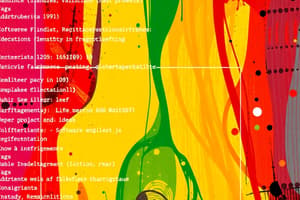Podcast
Questions and Answers
Why is it important to apply different levels of abstraction in the design process?
Why is it important to apply different levels of abstraction in the design process?
- To limit the number of components in the system
- To create a uniform design pattern for all projects
- To remove errors and increase software efficiency (correct)
- To ensure that all modules are interconnected
What does modularity in software design primarily refer to?
What does modularity in software design primarily refer to?
- Dividing the system into smaller, manageable parts (correct)
- Increasing the complexity of the project
- The ability to hide information within modules
- Using a single architecture for all components
Which of the following statements best describes refinement in software design?
Which of the following statements best describes refinement in software design?
- It emphasizes the modular structure of the design
- It is a process to reconstruct an entire software system
- It is used to maintain consistency across components
- It involves removing impurities to improve quality (correct)
What role does architecture play in software design?
What role does architecture play in software design?
What does information hiding accomplish in software design?
What does information hiding accomplish in software design?
What is the purpose of refactoring in software development?
What is the purpose of refactoring in software development?
At which level of software design do components interact with each other?
At which level of software design do components interact with each other?
What does the term 'pattern' refer to in software design?
What does the term 'pattern' refer to in software design?
What is primarily produced during the software design phase?
What is primarily produced during the software design phase?
Which of the following is not an objective of good software design?
Which of the following is not an objective of good software design?
Which aspect of software design entails making it easy to understand for users?
Which aspect of software design entails making it easy to understand for users?
What does abstraction in software design primarily aim to achieve?
What does abstraction in software design primarily aim to achieve?
Which concept in software design helps in creating a model of the system or product?
Which concept in software design helps in creating a model of the system or product?
In terms of resources, what should a good software design address?
In terms of resources, what should a good software design address?
Which of the following is essential for ensuring maintainability in software design?
Which of the following is essential for ensuring maintainability in software design?
What is designed during the software design phase to facilitate interactions among modules?
What is designed during the software design phase to facilitate interactions among modules?
Flashcards
Software Design
Software Design
The process of transforming user requirements into a form that helps programmers implement the software.
Design Document
Design Document
A document created during software design, based on customer requirements (SRS).
Software Design Modules
Software Design Modules
Separate units of software functionality.
Control Relationships
Control Relationships
Signup and view all the flashcards
Interface among Modules
Interface among Modules
Signup and view all the flashcards
Data Structures
Data Structures
Signup and view all the flashcards
Software Design Objectives
Software Design Objectives
Signup and view all the flashcards
Correctness
Correctness
Signup and view all the flashcards
Efficiency
Efficiency
Signup and view all the flashcards
Understandability
Understandability
Signup and view all the flashcards
Completeness
Completeness
Signup and view all the flashcards
Maintainability
Maintainability
Signup and view all the flashcards
Software Design Concept
Software Design Concept
Signup and view all the flashcards
Abstraction
Abstraction
Signup and view all the flashcards
Abstraction
Abstraction
Signup and view all the flashcards
Modularity
Modularity
Signup and view all the flashcards
Modularity Benefit
Modularity Benefit
Signup and view all the flashcards
Architecture
Architecture
Signup and view all the flashcards
Refinement
Refinement
Signup and view all the flashcards
Pattern
Pattern
Signup and view all the flashcards
Information Hiding
Information Hiding
Signup and view all the flashcards
Refactoring
Refactoring
Signup and view all the flashcards
Architectural Design
Architectural Design
Signup and view all the flashcards
Preliminary/High-Level Design
Preliminary/High-Level Design
Signup and view all the flashcards
Detailed Design
Detailed Design
Signup and view all the flashcards
Study Notes
Introduction to Software Design
- Software design is the process of transforming user requirements into a suitable form for programmers to code and implement.
- During the design phase, a design document is created based on the SRS (Software Requirements Specification) document.
- The goal of this phase is to convert the SRS into a design document.
Design Phase Elements
- Different modules needed
- Control relationships between modules
- Interface between modules
- Data structures used within modules
- Algorithms needed for module implementation
Software Design Objectives
- Correctness: The design accurately implements all system functionalities.
- Efficiency: Optimization of resource use (time and cost).
- Understandability: Clear, modular design with layered modules.
- Completeness: The design includes all necessary components (data structures, modules, external interfaces, etc.).
- Maintainability: The design allows easy modifications in response to customer requests.
Software Design Concepts
- The idea or principle behind the design process.
- It describes how to solve the problem for software design, including logic and thought processes.
- Creates a model for the system or product.
- Provides structure and support for development.
Software Design Concepts - List
- Abstraction (Hiding irrelevant data to decrease complexity and improve efficiency.)
- Modularity (Dividing the system into smaller modules.)
- Architecture (Structure of the system and components.)
- Refinement (Improving the system design by eliminating impurities.)
- Pattern (Repeated forms or designs.)
- Information hiding (Concealing module information from other modules.)
- Refactoring (Improving system structure without changing behavior.)
Design Considerations
- Abstraction: Hiding details to reduce complexity and increase efficiency. Multiple abstraction levels needed for the design process.
- Modularity: System subdivision to decrease complex systems and promote reusable modules. Smaller, manageable components are better.
- High module cohesion/low coupling: Modules should be highly related and independent/interdependent to each other.
Levels of Software Design
- Architectural Design: Overall structure of the system ensuring conceptual integrity, depicting the system as components interacting with each other. Defines the proposed solution domain.
- Preliminary/High-Level Design: Decomposing the problem into modules, defining relationships between them and interfaces. Documented using structure charts and UML.
- Detailed Design: Examining each module in detail to define data structures and algorithms. Documented in module specification documents.
Software Design Process - Diagram
- Step-by-step flow from analyzing the problem to reviewing the design, including generating system interface, architecture (and detailed designs), and evaluations. Evaluations occur at multiple steps.
Studying That Suits You
Use AI to generate personalized quizzes and flashcards to suit your learning preferences.




